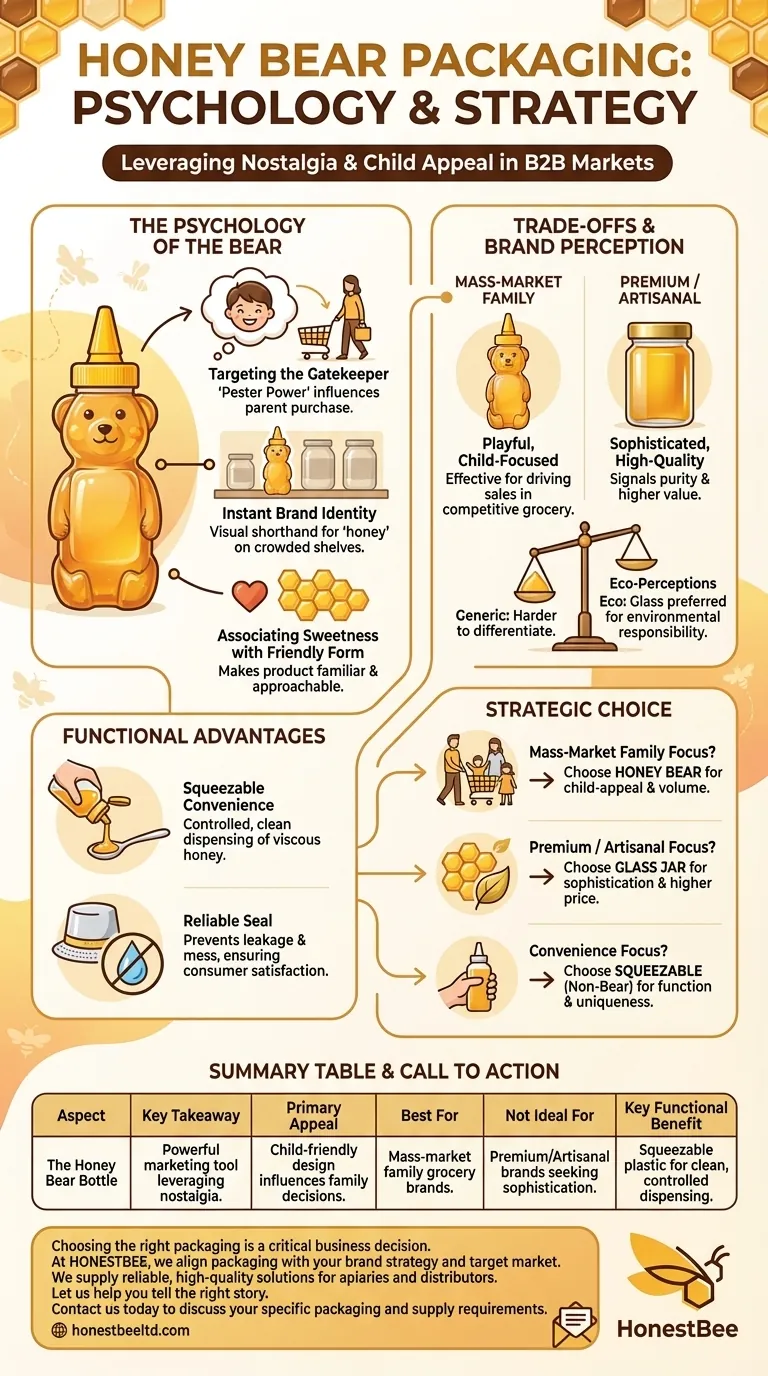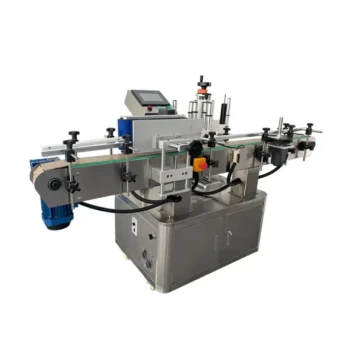At its core, honey bear packaging is a squeezable plastic bottle shaped like a small bear, often with a pointed cap. Its popularity stems from its highly recognizable and friendly shape, which is exceptionally appealing to children and creates an immediate, emotional connection with family shoppers on a crowded store shelf.
The honey bear bottle is more than just a container; it's a powerful marketing tool. Its success hinges on leveraging nostalgic, child-friendly appeal to influence purchasing decisions, but this same strength can be a liability for brands targeting a premium or artisanal market.

The Psychology of the Honey Bear: Why It Works
The enduring popularity of the honey bear bottle is a case study in effective package design that targets a specific emotion and consumer demographic. It works by creating a shortcut in the buyer's decision-making process.
Targeting the Gatekeeper Through the Child
The primary target of the bear shape is not the adult grocery shopper, but their child. Children are drawn to the friendly, toy-like character, and their preference often influences the parent's final purchase decision. This is a classic marketing strategy known as "pester power."
Creating an Instant Brand Identity
On a shelf filled with generic glass jars and simple cylindrical bottles, the bear shape is instantly recognizable. It acts as a visual shorthand for "honey," creating a distinct identity even in the absence of a strong brand name. For many consumers, the bear is the brand.
Associating Sweetness with a Friendly Form
The design cleverly links the product's key attribute—sweetness—with a form that is universally seen as gentle and approachable. This association makes the product feel more familiar and less like a generic commodity.
Functional Design and Practicality
While marketing is its primary strength, the honey bear bottle also has functional advantages that contribute to its success.
The Squeezable Advantage
Honey is a viscous liquid that can be messy to dispense from a wide-mouth jar with a spoon. The honey bear is almost always made from a soft, squeezable plastic, allowing for controlled, clean dispensing directly onto food.
The Importance of a Reliable Seal
Regardless of the shape, all honey packaging must prevent leakage. Modern packaging equipment, including systems with suck-back devices, ensures that the sticky product doesn't create a mess on the bottle or the cap after filling and sealing, a critical factor for consumer satisfaction.
Understanding the Trade-offs: When the Bear Isn't Best
Despite its popularity, the honey bear is not the right choice for every brand. Its distinct identity comes with significant trade-offs that can work against a producer's goals.
The Conflict with a Premium Image
The playful, child-focused design can project a mass-market, or even "cheap," image. For artisanal, single-origin, or raw honey producers who want to signal quality and sophistication, a simple glass jar often communicates a more premium value.
Risk of Becoming a Generic Symbol
The honey bear is so successful and ubiquitous that it has become a category symbol. Using it can make it harder for a specific brand to differentiate itself. Your product may be seen as "just another honey bear" rather than a unique offering.
Material and Environmental Perceptions
Many consumers associate glass with purity and environmental responsibility. While modern plastics are safe and recyclable, a brand targeting eco-conscious or health-focused buyers might find that a glass container better aligns with its brand story.
Making the Right Choice for Your Goal
Ultimately, the decision to use a honey bear bottle should be a strategic one based on your brand identity and target customer.
- If your primary focus is the mass-market family consumer: The honey bear is a proven, effective choice that leverages child-appeal to drive sales in a competitive grocery environment.
- If your primary focus is the premium or artisanal market: A high-quality glass jar or a unique, non-bear bottle will better convey sophistication, purity, and a higher price point.
- If your primary focus is convenience and ease of use: The squeezable format is a major functional benefit, but consider a non-bear "beehive" or simple inverted bottle shape to be different.
Choosing your packaging is choosing the first story you tell your customer, so make sure it aligns with the quality of the product inside.
Summary Table:
| Aspect | Key Takeaway |
|---|---|
| Primary Appeal | Leverages nostalgic, child-friendly design to influence family purchasing decisions. |
| Best For | Mass-market brands targeting the family consumer in grocery stores. |
| Not Ideal For | Premium or artisanal brands seeking to project a sophisticated, high-quality image. |
| Key Functional Benefit | Squeezable plastic allows for clean, controlled dispensing of viscous honey. |
Choosing the right packaging is a critical business decision.
At HONESTBEE, we understand that your packaging needs to align with your brand strategy and target market. Whether you are a commercial apiary scaling up production or a beekeeping equipment distributor sourcing for your clients, we supply the reliable, high-quality packaging and equipment you need to succeed.
Let us help you tell the right story. Contact our team today to discuss your specific packaging and supply requirements.
Visual Guide

Related Products
- Classic Honey Bear Jars with Flip Top Dispensing Cap for Liquid Sweeteners
- Squeezable No-Drip Beehive-Shaped Honey Jars with Flip-Top Cap
- Inverted Squeezable Honey Jar with No Drip Flip Top Cap for Easy Pouring
- Premium Diamond-Faceted Glass Honey Dispenser
- Natural Wood Honey Dipper for Tea Coffee and Desserts
People Also Ask
- What are the benefits of squeeze bottles for honey packaging? Unlock Mess-Free Convenience & Control
- How should honey bottles be prepared before pouring honey into them? The #1 Rule for Honey Longevity
- How long to let honey settle before bottling? Achieve Crystal-Clear Honey for a Premium Product
- What packaging issues can arise from excess moisture in honey? Prevent Container Failure & Spoilage
- What are the common types of honey packaging? A Guide to Glass, Plastic, Pouches & Tins



















